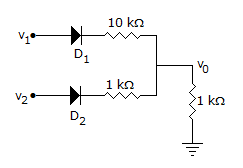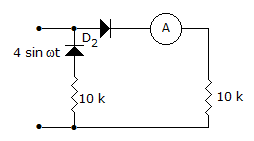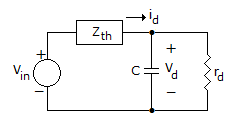Test: Analog Electronics - 5 - Electrical Engineering (EE) MCQ
25 Questions MCQ Test - Test: Analog Electronics - 5
A CB amplifier has a = 0.98 and RL = 600 Ω. If IE = 3.5 mA, the current gain is
| 1 Crore+ students have signed up on EduRev. Have you? Download the App |
Assertion (A): In an RC coupled amplifier the junction capacitances can be neglected at low frequencies but not at high frequencies
Reason (R): Capacitive reactance is inversely proportional to frequency.
In a full wave rectifier circuit using centre tapped transformer, the peak voltage across half of the secondary winding is 30 V. Then PIV is
In the circuit of figure both diodes are ideal. If v1 = 10 V and v2 = 10 V which diode will conduct?
In the circuit of the given figure, assume that the diodes are ideal and the meter is an average indicating ammeter, the ammeter will read
As compared to a full wave diode rectifier circuit using centre tapped transformer, the bridge diode rectifier circuit has the main advantage of
A dc power supply has no load voltage of 30 V and full load voltage of 25 V at full load current of 1 A. The output resistance and voltage regulation respectively are
If a = 0.995, IE = 10 mA, ICO = 0.5 mA, then ICEO will be
Assertion (A): In class C amplifier the efficiency is more than that for other classes of amplifiers
Reason (R): In class C amplifier we can get high efficiency over a wideband
In the following figure C = 0.02 μF, and Vth is known to be of frequency ω = 107 rad/sec and rd = 2.5 Ω and ZTh = RTh = 10 Ω Then phase angle between id and Vd

A class C amplifier has input frequency of 200 kHz. If width of collector pulses is 0.1 μs, duty cycle is
In a transistor the minimum and maximum values of βdc are 100 and 121. The proper value of βdc to be used to locate Q point is
The input to an op-amp integrating amplifier is a constant voltage. The output will be
FET amplifier is more difficult to analyse than BJT amplifier.
In a CE amplifier the dc load line is the same as ac load line when
If the output current wave shape of class C circuit has a period of 1 μs and a pulse width of 0.006 μs, the duty cycle is
Which configuration is suitable for impedance matching?
A BJT is said to be operating in saturation region if



 .
.
 .
. .
.
 2 - JΩ
2 - JΩ 26.56 .
26.56 . .
. or C
or C  1000 mF.
1000 mF. .
.














